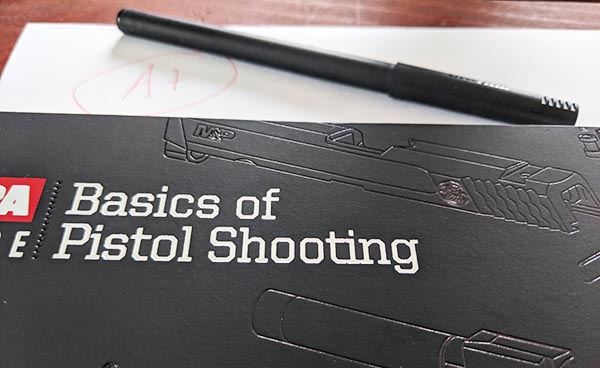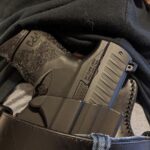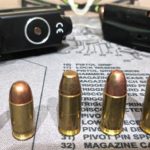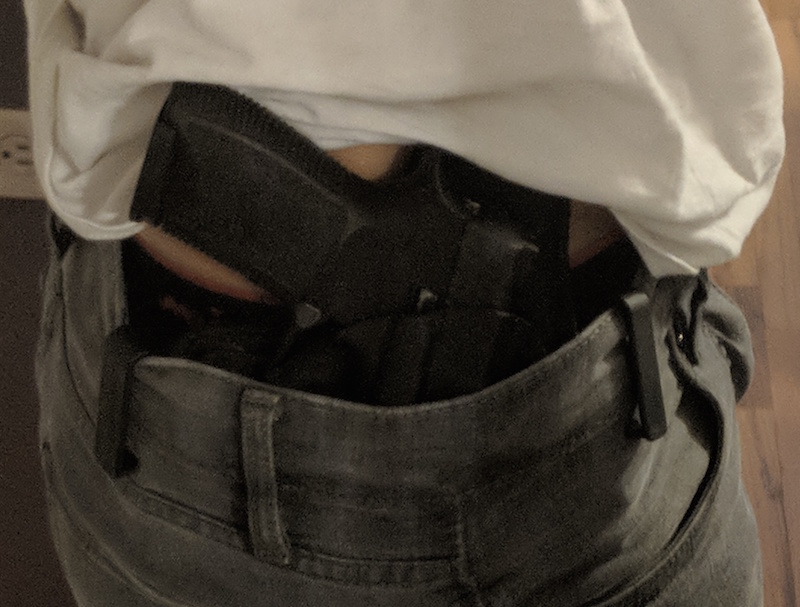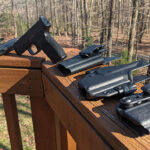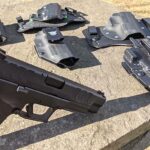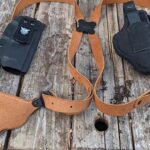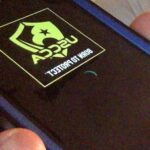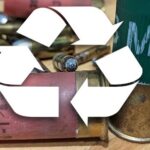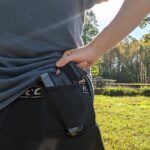If you’re looking for a study guide to help ace your concealed carry exam, then look no further. Today, I’m covering topics your are likely to encounter on any given concealed carry test. Additionally, the information provided was hand picked from a recent course I took from a VERY credible national firearm organization.
Therefore, the items I talk about are of the utmost importance. By the end of this article, you should be able to answer practice test questions on all of the following topics:
- List the 3 basic rules of firearms safety.
- What are the 3 major components of a pistol?
- Describe the difference between double-action and single-action.
- What’s the difference between a revolver and a semi-automatic?
- List the cycles of operation on a pistol.
- What are the 4 components of a cartridge?
- Name the two primary types of cartridges.
- Identify the fundamentals of shooting, and which are the 2 most important.
- What are the difference between the weaver and isosceles shooting positions?
- Most common aiming errors are the result of what?
- What are the major causes of a stoppage?
- In the event of a failure to fire, how long should you keep the muzzle pointed down range?
- Describe the difference between failure to extract and failure to eject.
- When cleaning a handgun should ammunition be present?
Although I’ve tried to be thorough in this article, each instructor will have their own curriculum. The material I cover may not represent the entirety of your instructors lesson plan, but at a minimum this information should be covered.
If you are confident in your knowledge or are just here for practice, you can skip ahead to the concealed carry practice exam at the end of the article.
Table of Contents
Concealed Carry Test: Safety Rules Questions
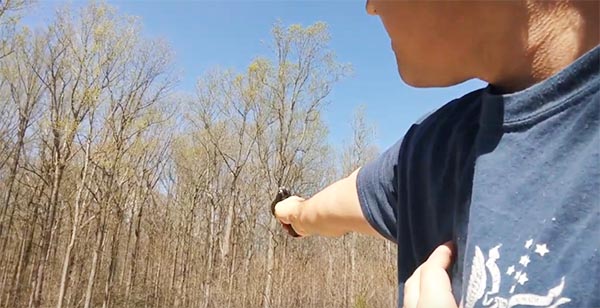
There are 3 rules that you should remember with regard to firearm safety for your concealed carry test. First, ALWAYS keep the gun pointed in a safe direction. Second, ALWAYS keep your finger off the trigger until you are ready to shoot. Finally, ALWAYS keep the gun unloaded until your are ready to use.
Firearm Safety Question Explanation
Each rule is essential to safe firearm handling and they are listed in order of importance. First, keeping the firearm pointed in a safe direction ensures that a negligent discharge or handgun malfunction mitigates the risk of injury. Therefore, the first rule of safety is your fail safe.
Second, you should keep your finger off the trigger until ready to shoot. This does NOT mean to rest your finger on the trigger guard. Instead, you should keep your trigger finger on the frame of the pistol to prevent accidental contact with the trigger. This is more commonly known as “trigger discipline.”
Keeping the gun unloaded until ready to fire means not haphazardly leaving your loaded handgun in a condition that could result in injury. When shooting at the range, keep the magazine ejected (on semi-automatics), action open, and chamber(s) empty if the gun is on the shooting bench.
If you want to explore additional safety rules, you can learn more here. I have added my own first rule that I was taught growing up. However, for the purposes of the concealed carry test questions, the above are the appropriate answers.
General Firearm Knowledge CCW Test Questions
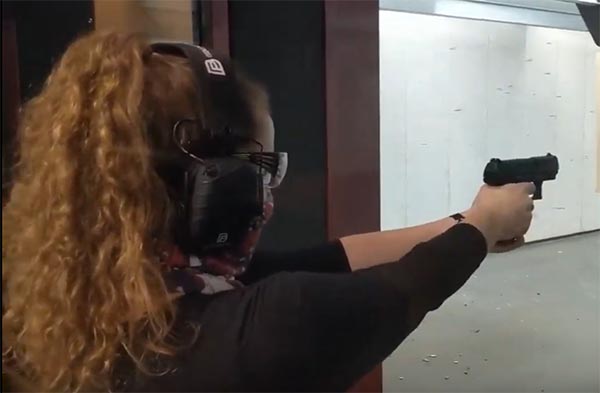
Firearm Component Questions
Next, I’ll discuss in depth the 3 major components of every modern handgun. Chances are, that your concealed carry test will cover the following information in several different questions. Additionally, concealed carry test questions will have other common terms as possible answers in an effort to confuse you. Therefore, to make it crystal clear, the 3 major components are:
- Frame
- Barrel
- Action
Additional Handgun Components
Every handgun consists of the frame, barrel, and action. However, this is an oversimplification of the construction. Below are additional parts of semi-automatics and revolvers, respectively.
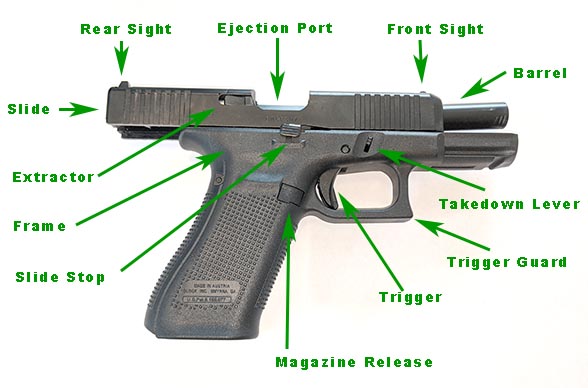
Description Of Parts On A Semi-Automatic
- Front Sight – used in conjunction with rear sight to achieve proper sight alignment
- Rear Sight – usually notched and used in conjunction with front sight
- Slide – recoils when a round is fired opening the ejection port to expel spent casing
- Ejection Port – location where spent casing is ejected from the chamber
- Extractor – responsible for removing spent casing from the chamber for ejection
- Guide Rod – guides the slide along appropriate path and is wrapped with the recoil spring, sits below barrel (not shown)
- Barrel – part of the gun that the bullet travels down
- Slide Stop – used to lock the slide in the rearward position
- Takedown Lever – used to field strip the gun for cleaning
- Frame – primary structure of the handgun
- Trigger Guard – area surrounding the trigger
- Trigger – used to drop the firing pin (can be double or single action or both)
- Magazine Release – ejects the magazine
- Magazine – houses cartridges to be loaded into the chamber during cycle of operation (not shown)
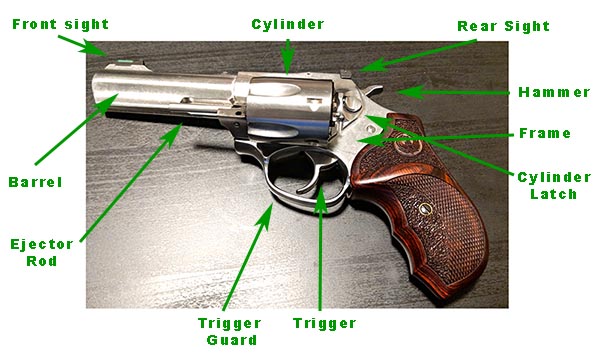
Description Of Parts On A Revolver
Front Sight – same function as a semi-automatic
- Rear Sight – same as a semi-automatic
- Cylinder – contains the independent chambers, rotates to bring chamber into alignment with barrel
- Ejector Rod – allows for cartridges/casings to be ejected en masse from the chambers (difficult to see, sorry)
- Cylinder Latch – controls the swinging of the cylinder outward to allow for ejection/reloading
- Hammer – can be found on some semi-automatics in lieu of the striker, strikes primer or controls firing pin
- Recoil Shield – blocks the rear of the chambers (not shown)
- Barrel – same as a semi-automatic
- Frame – same as a semi-automatic
- Trigger Guard – same as a semi-automatic
- Trigger – same as a semi-automatic
Double vs. Single Action Questions
Functionally, there are two types of handguns; double-action and single-action. However, a pistol may also be BOTH double-action and single-action and is commonly referred to as DA/SA. You can see animations of all different types of triggers on the site. So what exactly is the difference between “double action” and “single-action?”
When determining whether a pistol is double or single action, evaluate what action(s) does the trigger perform. If squeezing the trigger results in both the cocking and releasing of the hammer then the pistol is a double-action.
Contrarily, if the trigger performs only one action, releasing the hammer then the handgun is single action. This type of handgun will require the hammer to be manually cocked.
Finally, if a trigger can operate in either double-action or single-action, it is considered a DA/SA pistol. To learn more about DA/SA pistols you can read my other article.
Semi-Automatics vs. Revolver Test Questions
There are a few key differences between a revolver and a semi-auto (a.k.a. auto loader or automatic). First, a semi-automatic will have a single chamber, while a revolver has multiple chambers.
Second, semi-autos utilize a spring loaded magazine in order to feed rounds, while revolvers use a rotating cylinder, commonly referred to as the wheel. Therefore, in order to reload an automatic you simply need to replace the magazine. However, a revolver requires emptying the chambers using an ejector rod or manually unloading through the port. Then, chamber will need to be individually loaded.
Finally, during the cycle of operation, a semi-auto will eject a spent casing while a revolver simply rotates the wheel thereby changing the chamber.
Handgun Cycles Of Operation
Because the designs are different, revolvers and automatics have different cycles of operation. The cycle of operation defines the process that the handgun goes through when firing a round.
Below are the 7 steps in the cycle of operation. Above is a slow motion demonstration of the cycle of operation for a semi-automatic. Although the process has the same labeled steps, the cycle of operation on a revolver is slightly different dues to the design of the handgun.
Cycle Of Operation Semi-Auto
- Firing
- Unlocking
- Extraction
- Ejection
- Cocking
- Feeding
- Locking
Cycle Of Operation Revolver
- Cocking
- Unlocking
- Locking
- Firing
- Extraction*
- Ejection*
- Feeding
If you’re looking for additional information on cycles of operation for different types of firearms you can check out HowStuffWorks.
* Extraction/Ejection requires the manipulation of the wheel or loading gate and is not a mechanical process.
Concealed Carry Test Questions: Ammunition
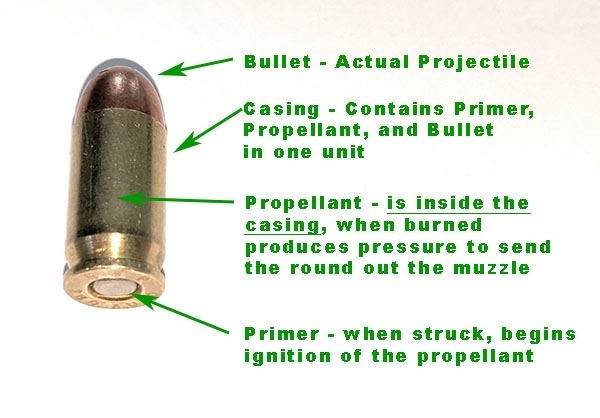
Construction Of A Cartridge
The cartridge is what most people refer to as the “bullet.” However, the cartridge actually consists of 4 separate parts.
- Casing (Case)
- Primer
- Propellant
- Bullet
The casing holds all of the other parts of the round in one unit. Brass is the most common material, although steel and other materials can be used. After a round is fired, the casing is all that remains in the gun. When a semi-automatic cycles the casing is extracted and ejected.
Next, we have the primer. When the trigger is squeezed, the firing pin strikes the primer which prompts the ignition of the propellant. If you press your own reloads, the primer is a one time use and will need to be replaced.
Now, lets talk about the propellant. Propellant burns and creates the pressure that ultimately forces the bullet down the barrel. Modern bullets use a smokeless powder, but traditionally guns used black powder.
Finally, we have the bullet which is the object that exits the muzzle and penetrates the target. Bullets come in a variety of configurations, such as frangible or hollow point. However, traditional bullets are more commonly referred to as ball ammunition.
Types of Cartridges
When it comes to handguns, there are two types of cartridges. First, we have rimfire ammunition which houses the priming mixture in the rim of the cartridge. Secondly, we have centerfire ammunition. Unlike rimfire ammunition, centerfire ammunition contains the priming mixture in the primer at the center of the case head.
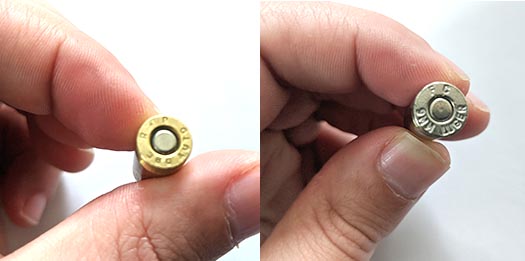
Before we go any further, I want to stress the importance of only using cartridges that are specifically made for your handgun. Rimifire ammunition is not to be used with centerfire handguns and vice versa. Different cartridge sizes and types are not interchangeable!
There are a few exceptions such as .38 special ammunition can be fired from a .357 magnum. However, just because a bullet fits into the barrel does not mean it is meant to be fired from that particular gun!
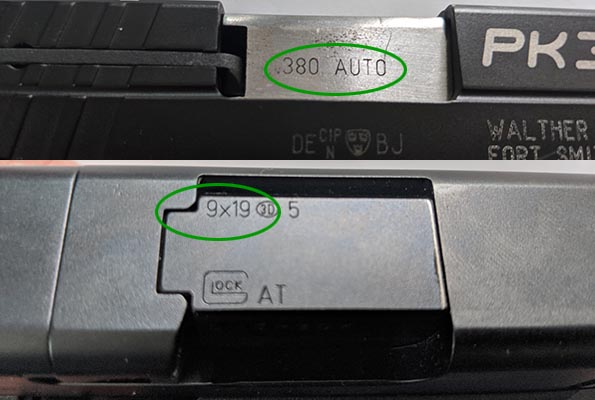
Although, you should consult the firearm owners manual, the caliber of cartridge a gun uses should be stamped on the slide, barrel, or frame. Furthermore, you can check the caliber of the cartridge by looking at the bottom of the casing where the primer resides. Above is an example of both of these scenarios.
Concealed Carry Test: Shooting Fundamentals
Accurate shooting incorporates your whole body, not just your trigger finger. Therefore, shooting stance is an important topic to cover. There are essentially 2 different stances for shooting; isosceles and weaver. However, there are also variations to each of these, and these two shooting stances represent the extremes.
Isosceles Stance Explanation
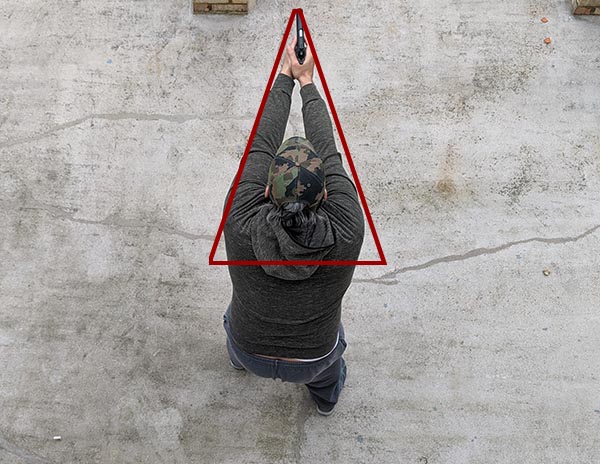
One of the most common shooting position that you’ll be questioned about on a concealed carry test is the isosceles stance. Additionally, the isosceles stance is named after the shape your arms make in relation to your body when viewed from above.
Above is a visual representation of the isosceles shooting stance. Notice the arms are extended and aligned with the center line of the shooters body.
Additionally, the front of the shooting side foot aligns with the instep of the non-shooting side. Feet are generally shoulder width apart in the isosceles shooting stance. All of these are generalizations and will vary from shooter to shooter.
Weaver Shooting Stance
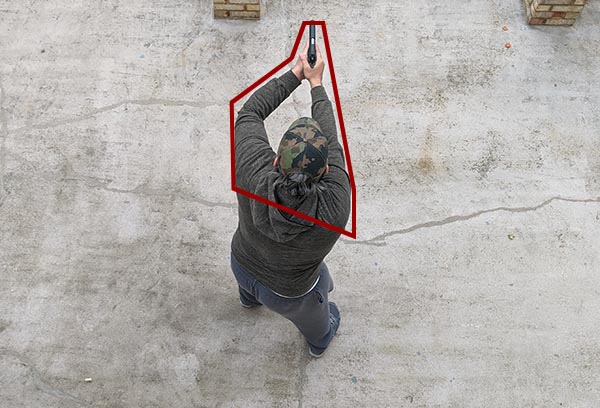
Contrary to the isosceles stance, the weaver stance is named after LA Sherriff Deputy Jack Weaver. The major difference between the Weaver and isosceles is the positioning of the shooters arms and torso.
The support arm is bent more so than the shooting arm in the Weaver stance. Additionally, the shooters shoulders will be slightly askew rather than square.
However, the lower portion of the shooters body will remain the same. Feet should be shoulder width apart and slightly staggered. Pictured above is an example of the weaver shooting stance.
Common Aiming Problems And Solutions
Inevitably, most common aiming problems can be traced back to sight alignment or sight picture. I cover this in greater detail in my article on using 3 dot sights.
Sight alignment is the relationship between the front sight post and the rear sight. However, our eyes are only capable of focusing on a single object at a time. Therefore, your focus should be on the front sight which leaves the rear sight and target slightly blurred.
Conversely, sight picture refers to the placement of properly aligned sights in relation to the target. Your sight picture can vary between guns and may change based upon shooting distance. However, for most guns the front sight should cover the target bullseye.
Other Shooting Fundamentals
Now that we’ve covered stance and aiming, lets talk about other shooting fundamentals that can impact your accuracy. Familiarize yourself with the below concepts for both your actual and practice concealed carry test.
Trigger Control
First, let’s talk about trigger control. Essentially, trigger control is the ability to manipulate the trigger while causing minimal movement of the sights. Some movement is inevitable. However, regardless of the speed with which you are required to shoot, maintaining trigger control will prevent unnecessary movement caused by jerking or flinching.
Of the shooting fundamentals, aiming (sight picture/alignment) and trigger control are the most important. Mastering these will make you a competent shooter and create a firm foundation for improving your shooting prowess.
Breath Control
Next, let’s discuss breath control which is the method to minimize gun movement while inhaling and exhaling. There are differing schools of thought on this topic. For the purposes of your concealed carry test, the recommended method of breath control is holding your breath to maximize accuracy and minimize body movement. However, others like myself prefer to break shots at the ending of an exhale.
Follow Through
Finally, we have the follow through. In shooting, the follow through is the maintenance of all other shooting fundamentals before, during and after firing a shot.
Once the bullet leaves the muzzle, your fundamentals have no bearing on the accuracy of that shot. However, focusing on the follow through prevents new shooters from prematurely abandoning shooting fundamentals to check their target. Additionally, proper follow through allows for better recovery and more accurate follow up shots.
Practice The Shooting Fundamentals
One of the most effective training methods for improving your shooting fundamentals is dry firing a gun. Dry firing is the execution of all the shooting fundamentals with an unloaded gun. However, dry fire practice must be deliberate otherwise you may reinforce bad habits.
Additionally, dry firing a gun can aid in your understanding of the cycle of operation. Furthermore, using your firearm for dry fire practice familiarizes you with the features (safeties, decocking lever, etc.) that may be specific to your model handgun.
CCW Practice Test: Identifying Malfunctions & Stoppages
Generally, any stoppage during a pistols cycle of operation is due to a problem with ammunition. However, problems with the firearm itself are possible. Next, I’ll be talking about the common reasons for a stoppage.
The most common cause of a stoppage is related to the ammunition. Oftentimes, this results in a failure to fire. A failure to fire means that the round is not discharged after the firing pin strikes the primer.
During your concealed carry test, the following sections may not be covered in their entirety. However, at least a portion of this material will be covered in the question and answer section. It’s important to familiarize yourself with this material as these are real world scenarios you will eventually encounter.
Light Strike
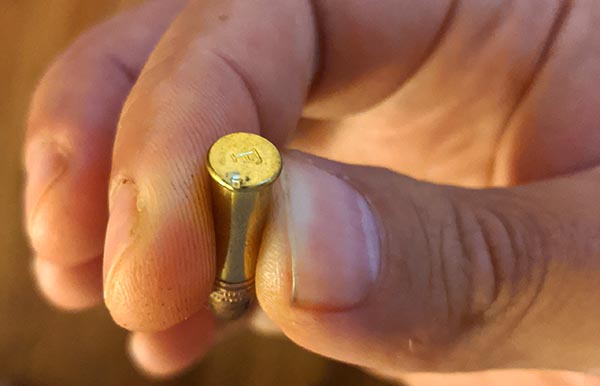
A light strike occurs when the firing pin hits the primer with insufficient force to cause ignition. When a light strike occurs, there will be no audible sound from the primer.
Pictured above is a light strike from a .22 rifle. Notice that the cartridge is still intact and the round has not been discharged. However, on most centerfire ammunition this indentation from the firing pin will be centered on the back of the round.
Squib Load
Another potential cause of stoppage is a squib load. A squib load occurs when the firing pin strikes the primer but there is insufficient powder to expel the round from the muzzle. Thus, the round becomes lodged in the barrel creating a blockage. Squib loads are one of the most dangerous types of stoppages.
Usually, a squib load is characterized by a “pop” rather than a “bang” when the round is fired. However, the reason this is one of the most dangerous types of stoppages is because the next round can be loaded into the chamber. When the following round is fired it hits the obstruction and can lead to serious injury.
Failure to Extract
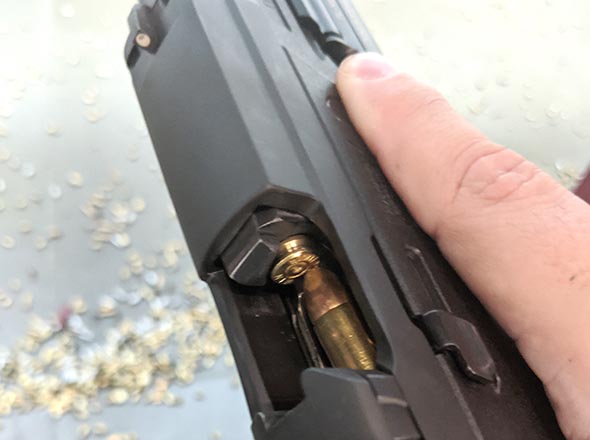
A failure to extract happens when the casing does not leave the chamber during the normal cycle of operation. This causes a stoppage because the next round in the magazine cannot be loaded into the chamber.
When a failure to extract occurs, a semi-auto will fail to go into battery. Additionally, when this occurs it looks to be a “double-feed.” However, the difference being that the handgun is not actually trying to load two live rounds consecutively.
Failure To Eject (Stovepipe)
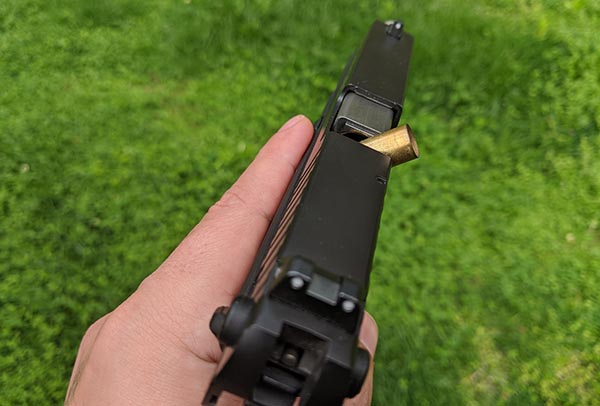
Unlike a failure to extract, a failure to eject means the casing interferes with the normal cycle of operation but is not stuck in the chamber.
Typically, this manifests itself in the form of the casing sticking out the top of the action. Therefore, it is called a stovepipe because of it’s likeness to the portion of a stove with the same name. A stovepipe will prevent the handgun from going into battery.
Hangfire
A hangfire occurs when the burn rate of the powder is slow enough to cause a delay in the discharge of the round. Similar to the squib load, this type of stoppage can be extremely dangerous.
Manually cycling the firearm can cause an active round to be laying on the ground ready to discharge in any direction. Another similarity between a hangfire and a squib load is the sound you hear when squeezing the trigger. Next I am going to cover what to do in the event of a failure to fire.
What To Do In A Failure To Fire Scenario
Unfortunately, when a shooter squeezes the trigger and the gun doesn’t discharge there is no way to know whether it is a squib load, hangfire, light strike, or dud round.
Therefore, common practice requires that you wait 30-60 seconds with the muzzle pointed downrange before ejecting the round. However, I usually err on the side of caution and wait 60-90 seconds before cycling my handgun.
Before proceeding, I clear the firearm. It’s important to visually inspect the barrel and chamber before continuing your live fire exercise to prevent injury.
Concealed Carry Test Question on Cleaning
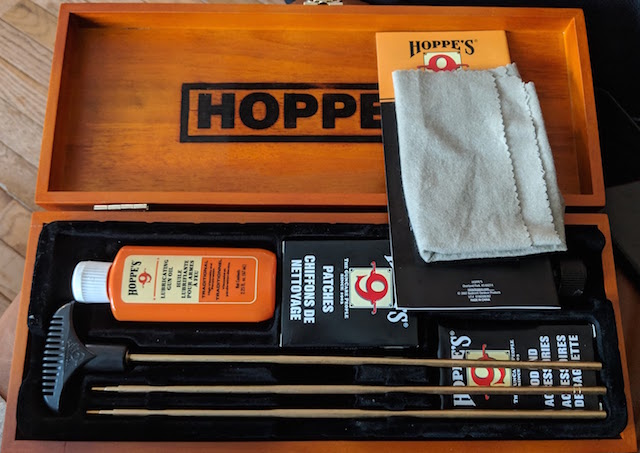
Part of concealed carry is responsible firearm ownership. Therefore, it’s important to regularly clean and maintain your handgun. Additionally, there will be at least one concealed carry test question about safely cleaning your handgun.
First, always clear the gun and verify unloaded. Ensure the magazine is ejected and there are no live rounds in the chamber. NEVER, under any circumstances should there be live ammunition present during the cleaning of your gun. I assure you that some form of this question will be asked on your concealed carry test.
Concealed Carry Practice Test Questions
Parting Shots
Hopefully these concealed carry test questions have helped prepare you for your real exam. I’ve tried to vary the types of questions to simulate what you will encounter on your concealed carry test. I encourage you to check out the rest of the site for additional information.
If you’re interested in learning more about what to expect from a concealed carry course, check out my other article. Each concealed carry course instructor will have their own way of presenting material. Additionally, each state may have different requirements so be sure to know what your state requires in terms of education.
If you found this information helpful, please leave a quick comment below. It helps me out immensely. Thanks for visiting the site, and good luck on your concealed carry test!
